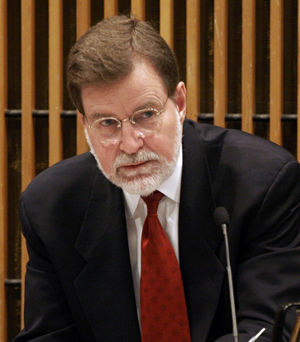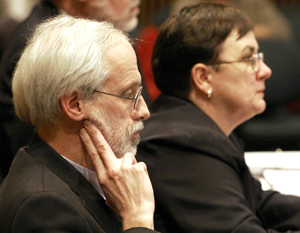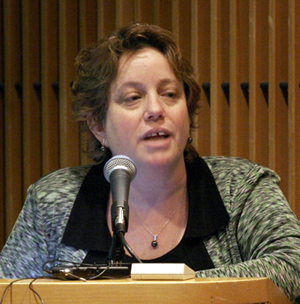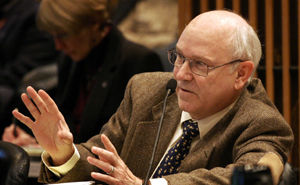
Environmental Factor, January 2008, National Institute of Environmental Health Sciences
NTP Board of Scientific Counselors Meets
By Eddy Ball
January 2008




With an observation that “this is a very active time in this field of ours,” NIEHS/NTP Acting Director Sam Wilson, M.D., opened the fall 2007 meeting of the NTP Board of Scientific Counselors (BSC) on December 6 in Rodbell Auditorium. Wilson’s statement soon became reality for members of the board as they plowed through a packed agenda of reports, two precedent-setting initiatives and seven nominations, including the second one involving a nanoscale element.
The meeting began with an update by NTP Associate Director John Bucher, Ph.D., who discussed NTP realignment (see related story(http://www.niehs.nih.gov/news/newsletter/bucher.cfm)) within the NIEHS Division of Intramural Research, an upcoming celebration of the 10-year anniversary of the Interagency Coordinating Committee on the Validation of Alternative Methods (ICCVAM) on February 5, 2008, and a workshop on in vitro approaches and humane endpoints for acute chemical safety testing on February 6 and 7.
Bucher acknowledged special recognition of several NTP staff. In 2006, Susan Elmore, D.V.M., and others from NTP were recognized for the year’s best paper by the Society of Toxicologic Pathology. Senior toxicologist Ron Melnick, Ph.D. received the 2007 David P. Rall Award for Advocacy in Public Health at the American Public Health Association’s 135th Annual Meeting in November. Bucher also noted the contribution of geneticist Frank Johnson, Ph.D. and the recent paper in Nature describing NIEHS/NTP efforts toward identifying single-nucleotide polymorphism maps of 15 commonly used laboratory murine strains.
ICCVAM and the NTP Interagency Center for the Evaluation of Alternative Toxicological Methods (NICEATM) in response to request from the U.S. House and Senate Appropriations Committees have developed a five-year plan to advance alternative test methods of high scientific quality to better protect human health, animal health and the environment. As an example of the potential of this kind of toxicity pathway analysis, Bucher pointed to the development of four in vitro alternatives to ocular testing. “If positive findings are coming up in these in vitro tests, there is no need to go on to a rabbit eye test,” he said.
In the first of two reports on initiatives that involve new directions in NTP studies, Dori Germolec, Ph.D., NTP immunology discipline leader, outlined plans for studying mold. The study will use pooled specimens of several fresh isolates of mold species on different building materials to mimic “real-life exposure” to whole organisms in rodent toxicology studies. As Germolec explained, the proposed study design “is a very significant departure from the traditional NTP study, where we’re using a very well characterized compound and have a very good idea of the metabolites and where they go in the tissues.”
In his report on nominations for the Center for the Evaluation of Risks to Human Reproduction (CERHR), Director Michael Shelby, Ph.D., described the proposed nominations of low-level exposures to lead and cadmium for expert panel evaluation. As Shelby noted, “This is the first time the BSC is being asked to provide input on whether there is sufficient concern and scientific data to warrant CERHR conducting an evaluation for a particular nominated substance.”
The lead nomination, Shelby noted, also marks the first evaluation by CERHR of a known developmental toxicant, and study results could support the first use of reproductive toxicity to revise occupational exposure limits downward. The current Recommended Exposure Limit is four times that considered elevated in children and applies to all workers, even women of childbearing age.
The board’s responses to reviews on the mold and proposed CERHR evaluations were overwhelmingly positive. The board also approved NTP recommendations for all study nominations except for the compound diethyl phthalate. The board also unanimously approved the recommendations on the findings and conclusions for the six draft NTP Technical Reports presented by Nancy Kerkvliet, Ph.D., chair of the board’s Technical Reports Review Subcommittee. The meeting concluded with a progress report by Bucher on implementation of the NTP Workshop and Retreat Recommendations.
Moving Day in Chicago —
Radiofrequency Radiation Studies to Begin Soon
During his report, Bucher showed slides of workers moving 21 reverberation chambers from flatbed trucks through the sidewalk into a sub-basement area at the Illinois Institute of Technology Research Institute in Chicago. The chambers, which were built in Switzerland and carried by sea to the United States, are being installed as part of NTP studies of exposure to radiofrequency radiation from cellular phones and other wireless communications devices.
According to Bucher, the thermal pilot studies are set to begin in February 2008, with the perinatal pre-chronic studies anticipated to start in the summer and chronic studies in 2009. The overall objective of these studies is to determine the potential toxic and/or carcinogenic effects of exposure to cellular phone radiofrequency emissions in laboratory animals. The Federal Communication Commission and others will use this information to determine the adequacy of current guidelines for protecting against potential adverse effects of chronic exposure. The current FCC exposure limits are designed to protect against acute injury from thermal effects of radiofrequency radiation.
"Leadership and Gener..." - previous story ![]()
![]() next story - "Former Postdoc Awarded..."
next story - "Former Postdoc Awarded..."
January 2008 Cover Page



